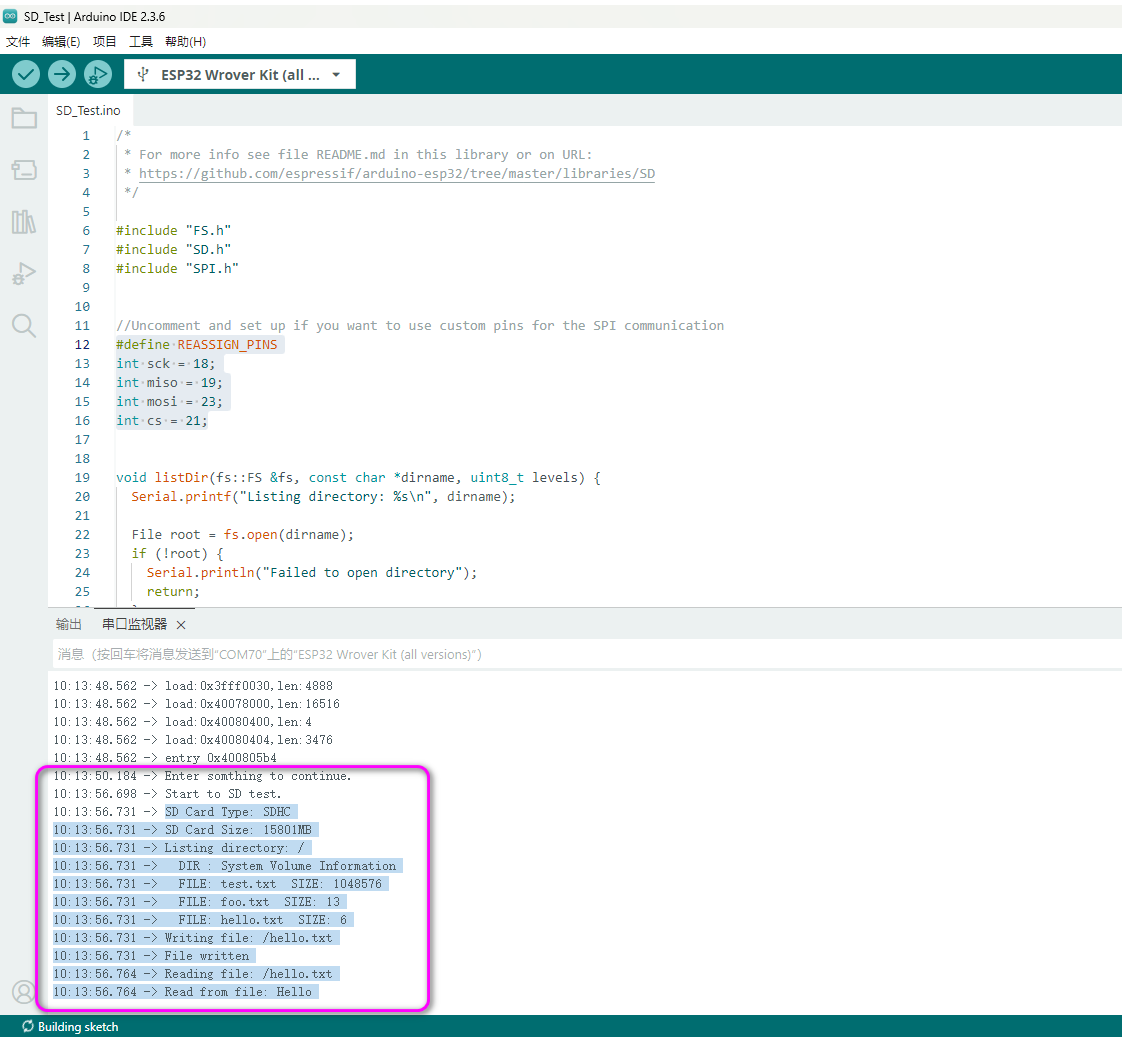在Arduino平台上使用ESP32开发板使用SPI SD卡示例;
1. 建立项目
在Arduino-IDE中安装好ESP32开发板后,新建项目后写入如下测试代码:
/*
* For more info see file README.md in this library or on URL:
* https://github.com/espressif/arduino-esp32/tree/master/libraries/SD
*/
#include "FS.h"
#include "SD.h"
#include "SPI.h"
//Uncomment and set up if you want to use custom pins for the SPI communication
#define REASSIGN_PINS
int sck = 18;
int miso = 19;
int mosi = 23;
int cs = 21;
void listDir(fs::FS &fs, const char *dirname, uint8_t levels) {
Serial.printf("Listing directory: %s\n", dirname);
File root = fs.open(dirname);
if (!root) {
Serial.println("Failed to open directory");
return;
}
if (!root.isDirectory()) {
Serial.println("Not a directory");
return;
}
File file = root.openNextFile();
while (file) {
if (file.isDirectory()) {
Serial.print(" DIR : ");
Serial.println(file.name());
if (levels) {
listDir(fs, file.path(), levels - 1);
}
} else {
Serial.print(" FILE: ");
Serial.print(file.name());
Serial.print(" SIZE: ");
Serial.println(file.size());
}
file = root.openNextFile();
}
}
void readFile(fs::FS &fs, const char *path) {
Serial.printf("Reading file: %s\n", path);
File file = fs.open(path);
if (!file) {
Serial.println("Failed to open file for reading");
return;
}
Serial.print("Read from file: ");
while (file.available()) {
Serial.write(file.read());
}
file.close();
}
void writeFile(fs::FS &fs, const char *path, const char *message) {
Serial.printf("Writing file: %s\n", path);
File file = fs.open(path, FILE_WRITE);
if (!file) {
Serial.println("Failed to open file for writing");
return;
}
if (file.print(message)) {
Serial.println("File written");
} else {
Serial.println("Write failed");
}
file.close();
}
void setup() {
Serial.begin(115200);
while (!Serial) {
delay(10);
}
delay(1000);
Serial.println("Enter somthing to continue.");
while (true) {
if (Serial.available() > 0) {
break;
}
}
Serial.println("Start to SD test.");
#ifdef REASSIGN_PINS
SPI.begin(sck, miso, mosi, cs);
SPI.setFrequency(4000000);
if (!SD.begin(cs)) {
#else
if (!SD.begin()) {
#endif
Serial.println("Card Mount Failed");
return;
}
uint8_t cardType = SD.cardType();
if (cardType == CARD_NONE) {
Serial.println("No SD card attached");
return;
}
Serial.print("SD Card Type: ");
if (cardType == CARD_MMC) {
Serial.println("MMC");
} else if (cardType == CARD_SD) {
Serial.println("SDSC");
} else if (cardType == CARD_SDHC) {
Serial.println("SDHC");
} else {
Serial.println("UNKNOWN");
}
uint64_t cardSize = SD.cardSize() / (1024 * 1024);
Serial.printf("SD Card Size: %lluMB\n", cardSize);
listDir(SD, "/", 0);
writeFile(SD, "/hello.txt", "Hello ");
readFile(SD, "/hello.txt");
}
void loop() {}
2. 连接硬件
这里按照如下引脚连接:
| ESP32 | SD-Card |
|---|---|
| 3.3V | 3v3 |
| GND | GND |
| 19 | MISO |
| 23 | MOSI |
| 18 | SCK |
| 21 | CS |
在软件中也可以根据需要更改引脚:
#define REASSIGN_PINS
int sck = 18;
int miso = 19;
int mosi = 23;
int cs = 21;3. 测试
Arduino-IDE中选择开发板串口,上传后打开串口监视器,输入一个任意字符后回车,即可看到如下Log,说明成功:


评论